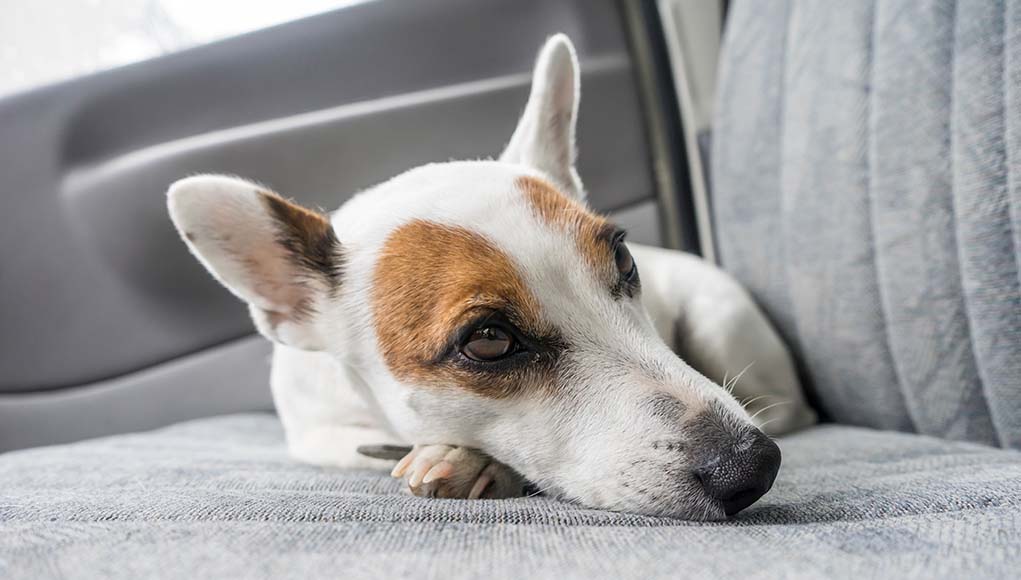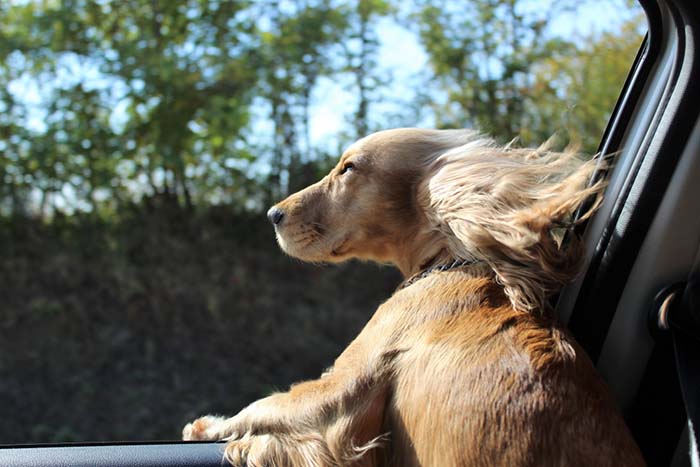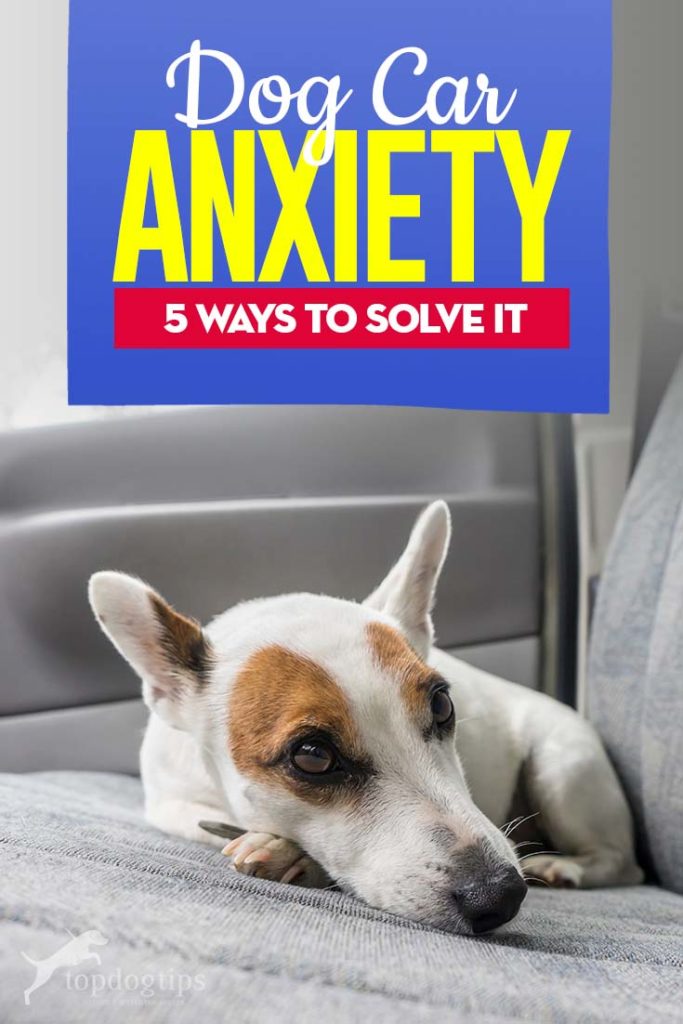Dogs with car anxiety may exhibit symptoms of panting, drooling, and the inability to relax or sit still. An anxious dog may also whine and shake, as well as urinate or defecate in the moving vehicle.
Causes of Dog Car Anxiety
A dog's sense of smell and hearing are much better than ours, so the very fact that they are in a moving vehicle means their senses are being overwhelmed and overstimulated. Even the rumble of the car's motor may be enough to set some dogs into panic-mode.
The sudden onset of car anxiety – after your dog has ridden before without any symptoms – could mean they're reacting to a recent bad experience. Perhaps you had to slam on the brakes to avoid an accident and Fido was launched forward and hit the floor; they could be associating this incident and the fear they felt to the vehicle itself.
Another bad-experience-related issue is a car ride that always ends in unpleasantness such as going to the vet or the groomers. Taking your dog on “fun” rides that result in going to the park or getting a special treat may make them less prone to car anxiety.
5 Ways You Can Solve Dog Car Anxiety
1. Practice
If your pooch has never been in a car or is reacting with any of the above symptoms, then you should start with short practice trips at first. With the windows open slightly (in warm weather) and a long-lasting treat in your dog’s possession, go for a short ride around the block or to your local park.
Watch your dog for visible signs of stress, and act accordingly. If the dog appears to be reactive to the sites and smells, close the windows and face your dog’s carrier forward. In addition, you may also use a lightweight towel draped over the carrier to block their view, making sure there is still plenty of ventilation.
The goal is to get your pup used to moving vehicle and the surroundings. The more you do this over and over, without accidents, sudden stops and having the trip end somewhere your pooch would be excited to go (e.g. dog park), the more accepting the dog will become of car trips.
2. Travel Breaks
Dog car anxiety may develop midway through, after the pup has gotten tired of traveling.
Your dog may automatically feel anxious if they're becoming uncomfortable in their car spot, or if they need to relieve themselves. Therefore, be sure they've done “the business” before you leave on any car rides, and walk the dog before you leave on your trip. Ideally, have a playtime session and tire them out, so your pup can sleep in the car.
If the trip you are on is lengthy, stop every hour or two so Fido can get out of the carrier and stretch their legs and go potty if necessary.
3. Travel Carriers or Booster Seats
Dogs should never be roaming freely and unrestrained in a moving vehicle. Once you get something to keep your pooch in place, whether you are planning a long car trip or want your dog to become accustomed to the travel carrier or doggy car seat, making this spot a welcoming area is key to relieve dog car anxiety.
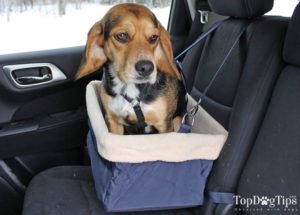 Not all crates are the same, and travel crates are specifically designed to keep your dog safe and comfortable on car trips. If you'd rather use a dog car seat instead, look for crash-tested ones, because no matter what the manufacturers claim about their seats, most of them may be dangerous to dogs.
Not all crates are the same, and travel crates are specifically designed to keep your dog safe and comfortable on car trips. If you'd rather use a dog car seat instead, look for crash-tested ones, because no matter what the manufacturers claim about their seats, most of them may be dangerous to dogs.
When using travel carriers, then crate training is crucial to avoid dog car anxiety. To train a dog for a travel carrier, familiarize the pup with it first. Bring out the crate and place it in a restful spot with the door open. Use a blanket to line the bottom. Make a trail to the carrier using your dog's favorite treats, pile some near the back of the carrier to encourage the pup to enter. Use a variety of treats to keep your dog coming back to investigate it each day.
Once your dog goes willingly into their travel carrier, offer them a longer-lasting treat like dog chews or a KONG stuffed with peanut butter. This type of treat will keep your pet engaged and busy while you slowly close the door. Allow your dog to stay in the carrier, with the door closed, for longer periods during each session. If your dog shows signs of anxiety, release her and continue with crate training the next day.
4. Travel Speed and Road Conditions
If your dog experiences travel sickness (nausea and vomiting) paying attention to your driving speed and road conditions may help. For example, if you tend to have a lead foot and are driving on a winding road at breakneck speeds, the back-and-forth motion may contribute to your dog’s sickness, which in turn may also make them more anxious.
If there's no way to avoid this with better driving, you may need to discuss the options of travel sickness pills for dogs with your veterinarian.
5. Calming Supplements, Music, Collars, and More
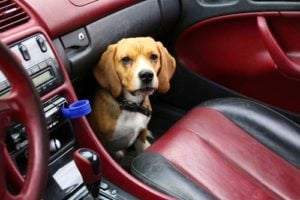 Finally, if you have tried all the “tricks” and nothing seems to help to relieve dog car anxiety, there are several additional tools. You can use each separately or all of them together to keep your dog calm and anxiety-free during car trips.
Finally, if you have tried all the “tricks” and nothing seems to help to relieve dog car anxiety, there are several additional tools. You can use each separately or all of them together to keep your dog calm and anxiety-free during car trips.
Calming supplements and sprays made for anxious pets is one option, and there are both natural and non-natural products. For example, lavender has natural calming properties and is available in many forms. Try lavender-infused cotton balls: a few days before your planned trip, dab lavender oil on cotton balls and store them in a zipper-bag. Once in the car, open the bag and allow the scent to permeate the area.
Dog pheromone sprays and collars have been proven to be very effective at calming. These work by targeting the dog’s “feel good” area of the brain, producing a calming effect. Pheromone sprays can be spritzed onto your pup’s favorite blanket or toy and placed inside the crate with them to inhale the soothing smell. Or, you can use a calming collar instead for a similar effect.
Certain sounds make dogs calming, according to studies. Research has shown that playing classical music in particular can also help ease the stress of your anxious dog, both inside and outside the vehicle. If you cannot use classical music, you may also want to try some audiobooks for anxiety which have also been shown to have a calming effect on dogs.
The Best Dog Car Anxiety Relief Products
An easy way to fix dog car anxiety without making your dog consume medicine is through all-natural treats that have a calming effect. Simply treat him with some before, during and after a car ride, both as a praise/reward and to decrease your pup's level of anxiety.
For example, hemp has been proven to relieve all types of anxiety in dogs, and treats with hemp are now often used during many stressful situations, including car rides.
Suntheanine, which is a GRAS-designated form of L-Theanine, is another ingredient proven to stimulate a dog's brain while soothing them but not making the animal sleepy.
In addition, some other calming dog treats may contain Melatonin, L-Trytophan, thiamine and ginger, all of which relax your dog. Below are some of the best dog car anxiety relief products you can try.
| Preview | Product | Rating | |
|---|---|---|---|

|
Zesty Paws Calming Chews for Dogs Composure &... | 16,944 Reviews | Check Price |

|
Ikarian Health - Tranquility Calming Aid for Dogs... | 794 Reviews | Check Price |

|
NaturVet Quiet Moments Calming Aid Dog Supplement,... | 54,968 Reviews | Check Price |
Disclosure: We may earn affiliate commissions at no cost to you from the links on this page. This did not affect our assessment of products. Read more here and find full disclosure here.


